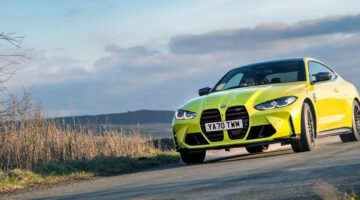| Superb drivetrain, classy and spacious interior, supple ride | |
| Styling still a little gawky, dynamically not exciting, price of options |
It would seem that it’s all about finding niches to fill these days and one look at the current BMW, Mercedes-Benz and Audi line-ups ably demonstrates this. These not-quite-core models are sometimes derided and BMW’s 5-series GT was one such machine. So it may have come as something of a surprise that it’s reimagined the model and moved it a little further upmarket with a 6-series moniker.
In truth it’s not really aimed at UK buyers – China and South Korea combined will take almost half of all 6 GT production during its lifespan – with the UK accounting for just four percent of sales. It deserves to do better than that over here though as it offers more space than a 5 Series Touring – especially in the rear – has plenty of luxury trappings and isn’t a bad steer by any means.
Longer, lower and sleeker than before it’s still not as easy on the eye as an Audi A7 Sportback but it offers more than the A7 in terms of accommodation and standard equipment. Three engine options are offered on the 6 GT – two petrols and one diesel – and it’s this latter model, the 630d GT that is the pick of the bunch, with the 3-litre mill having more than enough urge to propel the GT’s occupants rapidly while being cossetted in its luxurious cabin.
 BMW 6-series GT: in detail
BMW 6-series GT: in detail
Performance and 0-100 time > The stand out performer is the 640i xDrive with its four-wheel drive assisting its 5.3sec 0-100kph, impressive for a nigh-on two-ton machine.
Engine and gearbox > Three turbocharged engines are offered – a 2-litre four-cylinder petrol (630i), a 3-litre six-pot petrol (640i xDrive) and a 3-litre six-cylinder diesel (530d) – and all are equipped with the excellent eight-speed ZF auto.
Ride and handling > Make no mistake the 6 GT is a big, heavy car but it can still be hustled along pretty effectively and seems to share its dynamic DNA with the 5-series rather than the 7-series. Adaptive suspension endows a ride expected of a car with a GT moniker.
MPG and running costs > Official figures range from 35.3 to 55.3mpg (640i xDrive and 530d respectively) with the 630i sitting in between. Subtract a ten from those for real world expectations.
Design > Beauty is in the eye of the beholder but the 6 GT is much improved over the 5-series GT and it hides its bulk very well when viewed on the road. In the flesh there’s some nice detailing, too.
Prices, Specs and Rivals
Prices for the new 6-series GT start at $62,040 for the 630i SE and rise to $76,300 for the current range-topping 640i xDrive M Sport with the 630d costing around $1590 less than the equivalent 640i model. For the UK market the 630i is only available with rear-wheel drive, the 640i can only be had as an all-wheel drive xDrive model while the expected best seller, the 630d, can be optioned with either drivetrain.
Fortunately, BMW has moved away from its overly complex trim structure and has dropped the slow selling Luxury (and banished the horrendous, but short-lived, Urban trim to the history books) and GT buyers now have a simple choice; SE or M Sport, and BMW UK expects 80-85 percent of buyers to opt for the latter.
All models are pretty well specced but there’s still an extensive options list to be perused should you find the standard set up lacking. Selected highlights from the standard kit list include 18-inch alloys, eight-speed Sport automatic gearbox, self-levelling rear suspension, electric tailgate and adaptive LED headlights. Inside there’s Dakota leather, BMW’s 10.25-inch on board monitor with Professional Multimedia Navigation system, electric memory seats, two zone climate control, front and rear PDC and a reversing camera, too. M Sport models add 19-inch alloys, an M aero kit, M Sport brakes, M Sport suspension, a Panoramic glass sunroof and a smattering of M specific trim upgrades.
Options include several packages – M Sport Plus, Premium, Rear Seat Comfort and Technology – and just about anything that can be fitted to a 7-series can also be added to a 6 GT. If you were so inclined you could have a Head-Up display, Gesture Control, Massage seats, Ambient (scented) air, WiFi hotspot and a host of driver assistance items and the 7-series’ remote key-operated parking gizmo, too.
Such is BMW’s penchant for filling niches that some of the most compelling alternatives to the 6 GT come from within its own stable. The 5 Series Touring costs $5300 less in 530d guise but misses out on the 630d GT’s fully electric front seats and adaptive LED headlights and the traditional estate isn’t as roomy either with a smaller (by 40 litres with the seats up) boot and has less rear legroom, too.
The soon to be replaced 6-series Gran Coupe is a less practical but more stylish alternative although it’s considerably pricier and far less commodious. The 6-series GT could also be viewed as a cut-price 7-series if the more expensive car’s additional fripperies aren’t important and it’s worth noting that the GT has the same amount of rear legroom and a bigger boot – and in 630d M Sport guise is a whopping $18,500 cheaper than a 730d M Sport.
 The closest rival to the 6 GT is Audi’s ageing A7 Sportback, although a replacement is a matter of weeks away. It’s not as commodious as the 6 GT with the BMW having a larger boot and while BMW has stepped up its game in terms of interior design the Audi is still a very decent space to while away the time. In M Sport/S Line guises the equivalent 3.0TDI Audi is marginally (circa $1850) more expensive and has the less standard equipment, but counters by being slightly faster than the 630d M Sport.
The closest rival to the 6 GT is Audi’s ageing A7 Sportback, although a replacement is a matter of weeks away. It’s not as commodious as the 6 GT with the BMW having a larger boot and while BMW has stepped up its game in terms of interior design the Audi is still a very decent space to while away the time. In M Sport/S Line guises the equivalent 3.0TDI Audi is marginally (circa $1850) more expensive and has the less standard equipment, but counters by being slightly faster than the 630d M Sport.
Mercedes’ offering is the, again ageing, CLS and while the Coupe is more in line with the 6-Series Gran Coupe the Shooting Brake offers the sort of practicalities that the 6 GT and A7 major on. Despite its nigh-on five-metre length the Shooting Brake can’t match the BMW for space – it’s boot is smaller and with a wheelbase that’s 200mm shorter it’s no surprise the BMW has it beaten in terms of rear legroom, too.
Performance and 0-100 time
BMW might be keen to major on the Gran Turismo side of the GT’s character but despite this the benchmark sprint times demonstrate the big (err, coupe? Saloon? Low-slung SUV?) GT is no slouch. The entry-level 630i is equipped with BMW’s familiar 2-litre four cylinder which develops 255bhp from 5000-65000rpm and 295lb ft between 1550 and 4400rpm giving a 0-100kph time of 6.3sec and a 250kph maximum.
The range-topper for the time being is the 640i xDrive and its 3-litre turbocharged ’six pushes out 335bhp between 5500 and 6500rpm while that’s backed up by 332lb ft of torque that’s on tap all the way from 1380 to 5200rpm. Aided by its four-wheel drive traction it hits 100kph from rest in a pretty decent 5.3 sec, not bad when you remember it tips the scales at 1910 kilos.
We’ve yet to sample the four-cylinder model, but both the diesel and petrol ’sixes feel strong, and while the benchmark sprint might indicate the 640i is the quicker car, on the road the diesel’s 130lb ft torque advantage makes itself felt and of the two it feels the better choice. Keep it spinning in its torque sweet spot and it’ll cover ground deceptively quickly. The petrol does rev eagerly but starts to run out of puff a little towards its top end and as the GT is well insulated from the outside world the straight-six soundtrack isn’t all that conspicuous inside.
Engine and gearbox
All three engines come from BMW’s latest family of modular units with a 500cc cylinder capacity. Living in a world obsessed with downsizing both the petrol-engined models have smaller capacities than suggested by their model names, the 630i utilising the 2-litre four-cylinder TwinPower turbo unit that’s used across the range while the 640i’s 3-litre also uses a single twin-scroll turbo to develop its 335bhp. It’s the latter unit’s torque spread that gives an indication to how it’s been tuned – maximum thrust is available all the way from 1380 to 5200rpm and while it’s happy to rev further there isn’t really anything to be gained from doing so.
The 630d does stick to its promised capacity and even in these days of diesel demonification it’s the best engine in the range. Powerful, torquey and (whisper it) actually quite tuneful it does rock the GT along at quite an indecent pace and is as happy heading towards its red line as it is sitting at its torque-rich 2000rpm peak. Refined, economical and tuneful (for a diesel), it’s an engine that’s hard to fault.
 The standard fit ZF eight-speed auto is familiar not only with the rest of BMW’s range but from countless other applications but BMW does seem to have nailed the software for its cars and that’s certainly the case in the 6 GT. Left to its own devices it imperceptibly shuffles between ratios when you’re pottering along yet it’ll swap cogs in the blink of an eye when on a charge using the standard fit steering wheel paddles.
The standard fit ZF eight-speed auto is familiar not only with the rest of BMW’s range but from countless other applications but BMW does seem to have nailed the software for its cars and that’s certainly the case in the 6 GT. Left to its own devices it imperceptibly shuffles between ratios when you’re pottering along yet it’ll swap cogs in the blink of an eye when on a charge using the standard fit steering wheel paddles.
If you want BMW’s rear-biased xDrive four-wheel drive set up then it’ll be a case of choosing the 640i which is only available in this guise or adding it at a cost of $2650 to a 630d. Both the cars we tested – 630d and 640i – were so equipped but in the dry conditions we experienced you really don’t notice it’s there for 99 percent of the time. Only when really attacking a tight corner do you have an inkling that the front end’s receiving some additional assistance. Other BMWs – 530d and 730d which are both based on the same platform – work well without xDrive so unless you live in a part of the country that’s regularly subjected to severely inclement conditions we’d save the $2650.
Having driven both diesel and petrol models we’d recommend the 630d over its faster (on-paper) 640i xDrive counterpart. The diesel’s stronger torque not only enhances the driving experience but has the performance to get the best of the 6 GT’s not inconsiderable weight. It can also be pretty frugal when not on a charge – it even sounds pretty decent, too. It’s cheaper to buy and it’s the 630d version of the car that garners it a four-star rating.
Ride and handling
The 6 GT shares its platform with both the 5- and 7-series, although the GT uses the longer car’s architecture and shares its wheelbase with the Seven. Up front there are double wishbones while at the rear there’s a multi-link set up and self-levelling air suspension and ride quality can be adjusted between Comfort, Adaptive and Sport. Both our test cars were equipped with optional (at a hefty $2210) Adaptive twin axle air suspension and while it certainly assisted the GT in riding very well over a wide range of surfaces we would like to sample a car on the standard set up to confirm its ride credentials.
The 6-series GT is a big car but the use of aluminium and high-tensile steel has kept kerb weight down, despite it not featuring the 7-series’ carbon core. At 1900kg the 630d GT (rear-wheel drive) is a healthy 115kg less than the old 5-series GT and only 75kg more than the equivalent 530d Touring and on UK roads the 630d GT felt closer to a Five than a Seven when it came to driving dynamics.
If you bear in mind that it’s never going to feel like an M3 on the back roads the 530d can be hustled along very effectively, turning in well unless you’re overly ambitious while the 3-litre diesel’s decent slug of torque punches it out of corners with some pace. The diesel’s more impressive than the 640i petrol in this regard, feeling fleeter of foot on the move and less strained getting back up to speed.
The M Sport models we tested come as standard with BMW’s M Sport braking system – larger discs and four-piston front calipers – and these proved more than man enough to repeatedly haul nigh on two-tons down to appropriate cornering speeds although the pedal isn’t desperately feelsome.
evo comment
‘Such luxury doesn’t usually go hand in hand with driving thrills, and that’s still the case with the 640i. It feels ponderous as you try to feed it around corners at any reasonable pace; the steering is light and indistinct, the body rolls and the brakes do not inspire confidence, especially down hill.’
MPG and running costs
BMW’s latest generation of engines offer an excellent blend of power and economy when it comes to claimed figures although as with all manufacturers real-world MPG won’t match the showroom claims. The 630i GT is claimed to return 43.4mpg with emissions of 148g/km while the 640i xDrive comes in at 35.3mpg and 183g/km. Unsurprisingly it’s the diesel that should be the economy champion with 55.3mpg (49.5 for the xDrive) on the combined cycle with emissions of 135g/km (150 with four-wheel drive).
Realistically we’d knock up to 10mpg off those figures, and the 640i in particular seemed to like a drink when using the performance whereas the 630d was a little more parsimonious while on test.
With a three-year unlimited mileage warranty and the option to lock in servicing costs with BMW’s fixed price plans ownership should be a painless experience while residuals should sit in between the 5- and 7-series.
Design
The previous incarnation of this car – the 5-series GT – was often lambasted for its gawky styling and while the 6-series version hasn’t quite pulled off the ugly duckling metamorphosis it makes a passable attempt at a swan. Overall it’s 21mm lower than before, and perhaps most crucially the rear end is 64mm lower and along with the increase in length by 87mm the overall shape is sleeker than before.
On the road seen in amongst other traffic the GT doesn’t look overly large and hides its bulk well, the less intimidating kidney grilles (they’re more akin to the 5-series than the 7-series’ overly large nostils) help here. There’s some neat detailing too, the LED rear lights are strongly sculpted while the ‘Icon’ BMW LED headlights retain the family look.
 It’s inside that BMW has really concentrated it efforts and the overall architecture is shared with the Five and the Seven which are now at the top of their game. The 10.25-inch monitor can be used as a touch screen or with the iDrive controller and the Professional Multimedia system is second to none being both intuitive and informative.
It’s inside that BMW has really concentrated it efforts and the overall architecture is shared with the Five and the Seven which are now at the top of their game. The 10.25-inch monitor can be used as a touch screen or with the iDrive controller and the Professional Multimedia system is second to none being both intuitive and informative.
There’s a feeling of space that you don’t quite get with a 5-series Touring and those in the rear have plenty of head room while the longer wheelbase over a Five ensures there’s acres of leg room too. Boot space is huge – 610-litres with the seats up, 1800 with them folded – considerably more (110- and 110-litres respectively) than in the 5-series GT and larger than the new 5-series Touring, too.
There are a raft of options to choose from – ventilated, massaging seats, gesture control (don’t bother), Apple CarPlay and Bowers & Wilkins surround sound – but the standard machine comes with just about everything you could realistically need.









